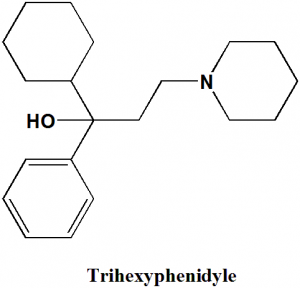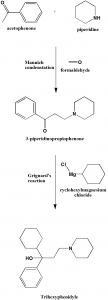TRIHEXYPHENIDYLE Synthesis, SAR, MCQ,Structure,Chemical Properties and Therapeutic Uses
Trihexyphenidyl
IUPAC nomenclature
(RS)-1-Cyclohexyl-1-phenyl-3-(1-piperidyl)propan-1-ol.
Classification
Trihexyphenidyl is an acetylcholine antagonist. It is a muscarinic antagonist.
Physiochemical Properties
| S. NO. | PHYSICAL AND CHEMICAL PROPERTIES | |
| 1 | Molecular weight | 301.5 g/mol |
| 2 | Physical appearance | Solid |
| 3 | Melting point | 258.5°C. |
| 4 | Solubility | 18 mg/L in water |
| 5 | Octanol/water partition coefficient | 4.49 |
| 6 | Presence of ring | Piperidine, benzene, cyclohexyl |
| 7 | Number of chiral centers | 1 |
Mechanism of Action
- It is a selective M1 muscarinic acetylcholine receptor antagonist.
- It partially blocks cholinergic activity in the central nervous system and reduces the symptoms of Parkinson’s disease.
- It also increases the bioavailability of dopamine which initiates and smoothly control the voluntary muscle movement. [1]
Structure Activity Relationship
- Either R1 or R2 must be heterocyclic or carbocyclic.
- The R3 group can be hydrogen, hydroxyl, hydroxymethyl or amide.
- Most potent derivatives has X as an ester.
- X can also be either oxygen or absent completely.
- The N substituent can be quaternary ammonium salt or tertiary amine or both with different alkyl groups.
- Maximum potency obtained when the distance between the ring substituted carbons is 2 carbon units.
Method of synthesis
i. Acetophenone and piperidine undergoes Mannich condensation in presence of formaldehydeto produce 3-piperidinopropiophenone.
ii. The latter compound undergoes Gringnard’s reaction with cyclohexylmagnesium chloride to give trihexyphenidyl.
Therapeutic Uses
Trihexyphenidyl is used for:
- Treatment of symptoms of Parkinson’s disease
Side Effects
Side effects of Trihexyphenidyl are:
- Dry mouth
- Dizziness
- Constipation
- Blurred vision
- Nervousness
- Nausea
- Flushing
MCQ
Q.1 “RS)-1-Cyclohexyl-1-phenyl-3-(1-piperidyl)propan-1-ol” is the IUPAC nomenclature of which drug?
a) Trihexyphenidyl
b) Propantheline
c) Oxybutynin
d) Oxazepam
Q.2 Melting point of Trihexyphenidyle is?
a) 152-162°C
b) 129-130°C
c) 205.5°C
d) 258.5°C
Q.3 Match the following with correct classifications of the drugs.
| i. Trihexyphenidyle | A. Benzodiazepine sedative-hypnotic |
| ii. Oxazepam | B. Barbiturate |
| iii. Clozapine | C. Muscarinic antagonist |
| iv. Thiamylal | D. Benzpines |
a) i-A, ii-C, iii-D, iv-B
b) i-C, ii-A, iii-D, iv-B
c) i-A, ii-B, iii-D, iv-C
d) i-C, ii-B, iii-A, iv-D
Q.4 Mechanism of action of Trihxyphenidyl is based on?
a) Blocking the Muscarinic acetylcholine receptors
b) Blocking the nicotinic acetylcholine receptors
c) Increasing the bioavailability of dopamine
d) Both a) and c)
Q.5 Correct sequence for True and False for the given statements related with the SAR of drug trihexyphenidyl
- Either R1 or R2 must be heterocyclic or carbocyclic.
- The R3 group can be hydrogen, hydroxyl, hydroxymethyl or amide..
- X can also be either oxygen or absent completely.
- The N substituent can be quaternary ammonium salt or tertiary amine or both with different alkyl groups.
a) TFTF
b) FTFT
c) TTTT
d)FFTF
Q.6 Steps involved in the synthesis of trihexyphenidyl from acetophenone in the correct sequence is?
I. Mannich condensation with piperidine
II. Grignard’s reaction with cyclohexylmagnesium chloride
III. Reaction with hydrazine
a) I – II – III
b) I – III
c) I – II
d) II – I – III
Q.7 The drug trihexyphenidyl is mainly used for?
a) Parkinson’s disease
b) Hypertension
c) Depression
d) Constipation
Participate in Free Online Test for GPAT, Pharmacist,Drug Inspector
ANSWERS
1-a
2-d
3-b
4-d
5-c
6-c
7-a
REFERENCES
[1] Jilani TN, Sharma S. Trihexyphenidyl. InStatPearls [Internet] 2019 Mar 27. StatPearls Publishing.

